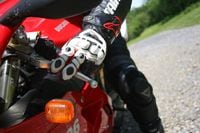Right now is a great time to get into the world of motorcycling, considering the abundance of new bikes and gear from which to choose. However, when it comes to finding the best motorcycle protective gear especially, the number of options can be overwhelming.
Shopping for a solid pair of gloves online can be like searching for new music on Spotify: before you know it, your trail which started with Robert Johnson has inexplicably lead to Enya and a weird mix of Ambient Chillwave. This simple guide is intended to help you navigate the gear world by getting you to ask the right questions before shelling out for a product that doesn't fit your needs. As for Spotify, you're on your own.
It has to be said right off the bat that protective motorcycle gear is crucial—even more so for a new rider. The adage, "Dress for the slide, not the ride," holds. These days, there are plenty of options that are protective, functional, and stylish. The excuse of "it's too hot to wear a jacket," doesn't hold up since there is a ton of protective hot weather riding gear out there. If you're willing to drop some serious coin on a cool jacket but still ride in plain old blue jeans and sneakers, you may want to rethink your strategy. Okay, we'll get off our soapbox.
When we evaluate gear, we take into account factors such as value, levels of protection, style, and functionality. It's unlikely that you'll find a piece of gear that gets a perfect score in every category. Even if you decide you want to get all decked out, you're going to have to decide what qualities you value most. If convenience and style are your priority, you may need to sacrifice a level of protection or functionality. For example, a stylish pair of riding denim—which is way more protective than normal jeans, by the way—are not ideal for long-distance tours where you might want waterproof material and higher levels of protection. Which brings us to the next point.
Identifying the type of riding you’re going to do will go a long way toward helping you narrow down your choices. Do you need gear you can wear on and off the bike? What kind of weather will you be riding in? Answering these questions will help you determine what type of gear you should look for.
Abrasion resistance is the name of the game when it comes to choosing what your gear is made from. We could go on and on comparing different textiles and leathers, but let's keep it simple. Leather is still probably the most abrasion-resistant of any material, but it has its drawbacks. If you plan on commuting daily or going on long trips where you might encounter rain, leather is not a great choice. Not only will you get soaked, but the leather can transfer its dye to your skin, giving you a blue-ish Smurf tint (if your gear is black), and it can take a long time to dry. Also, even perforated leather can be a bit stifling in hot weather.
As equally important as abrasion resistance in a piece of gear is impact protection. It's important to look for gear that is CE-rated, which indicates how much force a given product can absorb. CE level 1 is less protective than CE level 2.
We all want to save money where we can, but it’s important to buy gear from a reputable brand that specifically designs gear for motorcycling. Sure, a leather jacket from Joe Rocket or Dainese is likely more expensive than the one you’d pick up from a mall department store, but you’re paying more for hard-earned expertise.
In addition to armor, reinforced stitching, and comfort features like stretch panels and ventilation, a properly fitting bike jacket fits in a particular way that prevents material from folding or catching in a way that wears quickly or shifts armor away from the proper position in the event of a get-off.











/cloudfront-us-east-1.images.arcpublishing.com/octane/77DLIM3DNCGUMVTXBG3T5LHZEI.jpg)





/cloudfront-us-east-1.images.arcpublishing.com/octane/7GJYDUIPXRGMTMQKN6ONYOLBOU.jpg)
/cloudfront-us-east-1.images.arcpublishing.com/octane/MUQLOVLL2ZDGFH25ILABNBXKTI.jpg)
/cloudfront-us-east-1.images.arcpublishing.com/octane/TNOU5DNE2BC57MFPMGN2EIDXAM.jpg)
/cloudfront-us-east-1.images.arcpublishing.com/octane/GTCXACQGJ5HAPDTGWUQKDEH44E.jpg)
/cloudfront-us-east-1.images.arcpublishing.com/octane/S35YGSEMEZB4BLTDJTSZPF4GLA.jpg)
/cloudfront-us-east-1.images.arcpublishing.com/octane/5UOT6HPX2JFMRJAX6EH45AR4MQ.jpg)
/cloudfront-us-east-1.images.arcpublishing.com/octane/OKWOJWAKP5EP3OACCRRWPCIX2Q.jpg)
/cloudfront-us-east-1.images.arcpublishing.com/octane/2WF3SCE3NFBQXLDNJM7KMXA45E.jpg)
/cloudfront-us-east-1.images.arcpublishing.com/octane/G4MG6OUCJNBSHIS2MVVOTPX65E.jpg)
/cloudfront-us-east-1.images.arcpublishing.com/octane/IIGGWFOTOJGB7DB6DGBXCCMTDY.jpg)
/cloudfront-us-east-1.images.arcpublishing.com/octane/QSTCM6AVEZA5JJBUXNIQ3DSOF4.jpg)
/cloudfront-us-east-1.images.arcpublishing.com/octane/U4I7G625B5DMLF2DVIJDFZVV6M.jpg)
/cloudfront-us-east-1.images.arcpublishing.com/octane/B6XD6LS6IVCQPIU6HXDJSM3FHY.jpg)
/cloudfront-us-east-1.images.arcpublishing.com/octane/ICL63FEDDRDTTMINYICCEYGMDA.jpg)
/cloudfront-us-east-1.images.arcpublishing.com/octane/FCGZHQXRBZFLBAPC5SDIQLVF4I.jpg)
/cloudfront-us-east-1.images.arcpublishing.com/octane/WNOB6LDOIFFHJKPSVIWDYUGOPM.jpg)

/cloudfront-us-east-1.images.arcpublishing.com/octane/X33NU3E525ECRHXLNUJN2FTRKI.jpg)
/cloudfront-us-east-1.images.arcpublishing.com/octane/6KKT5NNL2JAVBOXMZYS5ZO76YA.jpg)
/cloudfront-us-east-1.images.arcpublishing.com/octane/J5RKG5O455GMPGQRF2OG6LRT7A.jpg)
/cloudfront-us-east-1.images.arcpublishing.com/octane/GX2CIZKQVRH2TATDM26KFG2DAE.jpg)
/cloudfront-us-east-1.images.arcpublishing.com/octane/ZWIDYSAKQZHD5BHREMQILXJCGM.jpg)
/cloudfront-us-east-1.images.arcpublishing.com/octane/CYUHJZCTSJCH3MRAQEIKXK7SCQ.jpg)
/cloudfront-us-east-1.images.arcpublishing.com/octane/LKOFINY56FCXJCANJ5M7ZDQUBY.jpg)